
On a warm dark night this summer, I found myself sat next to a glowing bright white ball in the garden, sunglasses over my eyes, watching moths of all sizes disappear into a big black box. Yes, I was getting eaten alive by mozzies and midges but I really didn’t care, because this was one of the undisputed wildlife highlights of my life. That might strike you as odd, given moths’ underwhelming reputation, but bear with me!
Until relatively recently I have no memory whatsoever of peering closely at a moth or even being remotely motivated to do so. What would be the point? They’re drab, boring wee things aren’t they? Hairy, clumsy, ungainly, they will eat through your entire house if you give them the chance. So nope, they’re not loveable. Quick! Switch the lights off and get those things away from me!
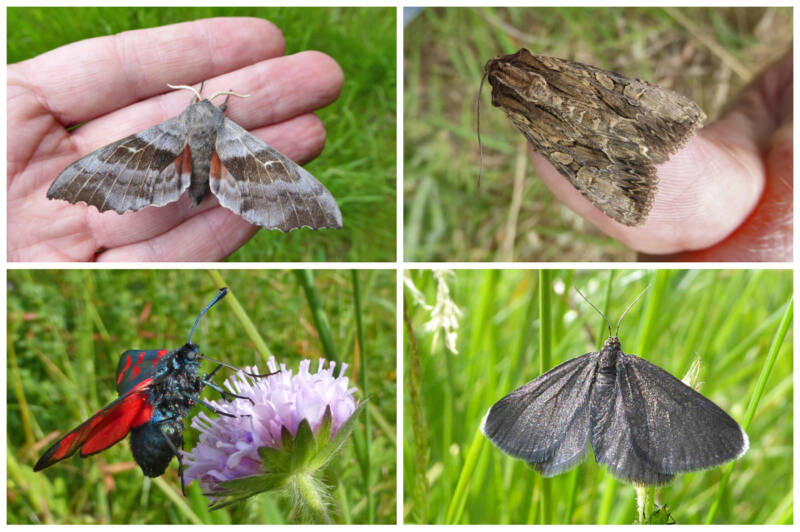
Misconceptions about moths abound. Most are indeed nocturnal but a sizeable proportion aren’t, and only a couple of species will munch through your household items. They play a massive role in pollination, especially unseen at night, and are in turn a food source for countless other birds and animals, both in their winged adult form but also as caterpillars. Bats would suffer greatly without moths, and where would those darling blue tits in your garden get such plentiful food to feed their massive broods?
Facts like these still don’t necessarily win moths friends, as people do find them difficult to love. My other half is a prime example, having been traumatised by a moth when he was younger. So you can well imagine his reaction when he opened the fridge one morning this summer and found moths in specimen jars, slumbering next to the yoghurt. As he himself said at the time:
If I hadn’t seen The Silence of the Lambs I wouldn’t be *quite* so disturbed.
I can vaguely recall being irritated by moths when I was a kid, when they were fluttering around my bedroom late at night and repeatedly bouncing off the lightbulb inside my Mr Men lampshade, but since then I’m rather ashamed to say I was simply indifferent. As with so many smaller creatures in this world, as a hillwalker I was aware of them flitting past from time to time…. but they never aroused any curiosity.
That changed around 2014when I bought a camera with a macro function. I started testing it on random insects and nonchalantly snapped a pic of a Latticed Heath moth in West Lothian. Although, given my long-standing moth ignorance I had no idea what species it was at the time.
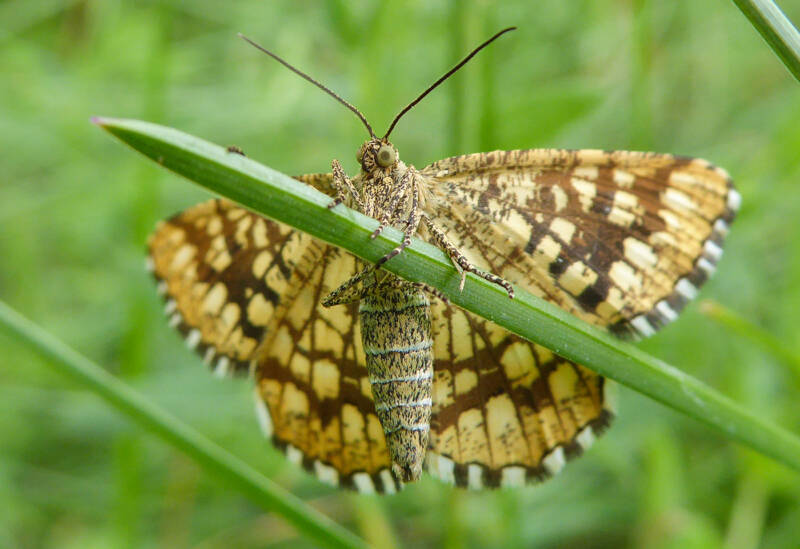
Before I took the photo it was just another drab brown blur that had fluttered past and settled on a blade of grass. There was no hint whatsoever of pattern, colour or detail, so what I saw when I zoomed in on the photo came as a surprise.
I saw a beautiful rusty brown creature with a stripy body, a delicate lattice on the wings, with striking black and white stripes around the edges. This ‘drab’ brown moth was one of the most intricately beautiful wee creatures I’d seen.
Its eyes looked like actual cartoon eyes rather than the usual alien insect compound eyes. They were almost expressive, and I know it sounds silly but this moth had….well….character.
That Latticed Heath piqued my interest, but a Garden Tiger sealed the deal when I inadvertently found one in my garden. Initially it looked like it was wearing a giraffe-print poncho, which was fascinating in itself but when it opened its forewings to reveal its volcanic orange hindwings underneath…..wow!
I’d always assumed that butterflies had the monopoly on intricate beauty, but moths are just very good at hiding it, either by using cover of darkness or the cover of their forewings. That perhaps explains why they are so easily overlooked.
Ever since then I’ve chased down any and every supposedly drab blur that’s fluttered across my path, and every new moth encounter for me is both an education and a joy. That admittedly means that moths are single-handedly responsible for nearly doubling the lengths of all my walks, but with every moth encounter the fascination only grows.
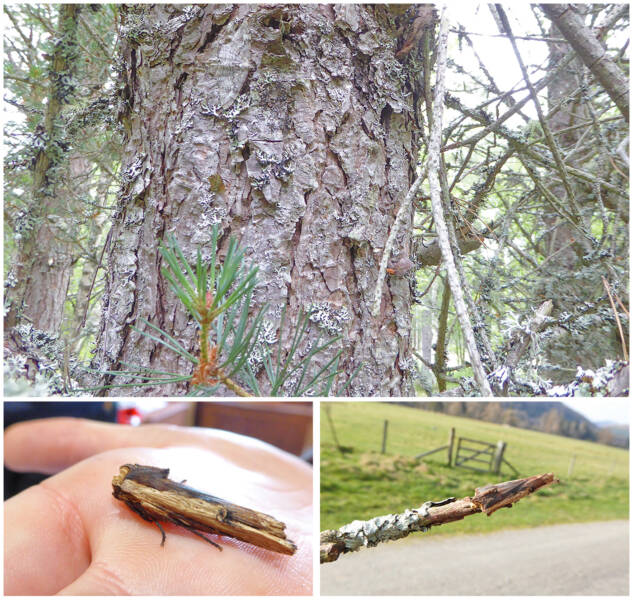
Bottom: A twig…otherwise known as the Red Sword Grass moth
I vividly remember following a drab grey blur (a Mottled Beauty) through a woodland, waiting for it to settle, only for it to instantly vanish from the face of the earth when it landed on the bark of a nearby scots pine. Even though the moth was just a few metres away from me when it settled, its camouflage was so effective it took me an absolute age to find it again. Many moths are impressively adept at hiding in plain sight, so if they are indeed subdued in appearance, consider that there might actually be a reason for that.
I was similarly taken aback when the ecologist at Mar Lodge came into the ranger office one day with a small twig in his hand. It took me a few seconds to realise it was actually a moth (Red Sword Grass), which we promptly took outside to find a real twig to sit it on. Genuinely, you couldn’t tell where one ended and the other began.
But not all moths need to hide in plain sight. Some can afford to be brazen with their use of colour, not least the Burnet moths and the Cinnabar with their lurid reds set against blue-black wings. Cinnabar caterpillars feed on ragwort and thus ingest a high level of that plant’s toxins, and burnet moths can release hydrogen cyanide if they are attacked. Their redness shouts ‘don’t eat me, you won’t like it!’ at would-be predators.
Patterns can also be a defence if you look like something else. For that reason it’s always a genuine thrill to encounter an Emperor moth, because the distinctive ‘eyes’ on its wings give it the appearance of a cat or an owl. But nothing quite beats finding a strange new moth in your house after dark on a warm summer night, and being given a rare opportunity to inspect a real curiosity at close quarters.
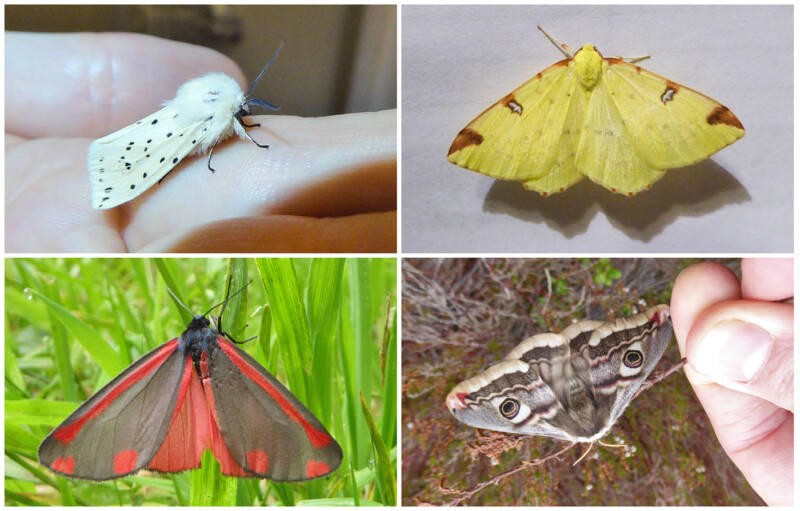
I once found a large white moth on my stairs at home, which bore an uncanny resemblance to a miniature Cruella de Vil. Sadly, it remains the only White Ermine I’ve ever seen.
Or the luminous Brimstone moth I found on my windowsill at Mar Lodge. Until then I don’t think I was even aware that we had anything as yellow as that flying about in Scotland. Oh and how can I forget being buzzed by a Hummingbird Hawk-moth on East Lomond? If you’ve never seen one, they’re easily one of our true wildlife highlights – they genuinely move with the precision and manoeuvrability of a hummingbird, hovering in front of flowers and using their proboscis to suck up nectar in the same way hummingbirds do with their beaks.
Hopefully this all gives a sense of how much variety you’ll find in moths, but it’s really not surprising given there are around 2,600 species in the UK. Around half of those are found in Scotland, and you’ll find them across pretty much every habitat you can imagine, from seaside to summit.
With butterflies, you could set yourself the task of spotting them all of them in one lifetime and you’d very well accomplish it within a few years. Maybe even in a single year if you put your mind to it. But with moths, the field is so broad and so diverse that you’re never going to do it.
That’s massively appealing to me because it feels like there’s an inexhaustible pool of fascination and beauty to jump into. It will ALWAYS be worth chasing moths down to see what they are, because there’s a good chance of seeing something you’ve never seen before. Course, the fact that most moths are nocturnal does make it more challenging, hence recently jumping at the chance to borrow a moth trap for the first time.
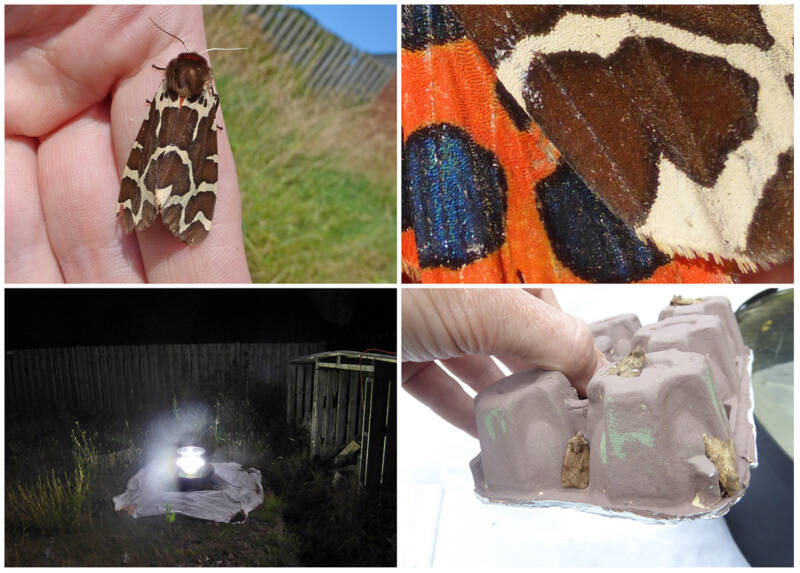
Bottom: First experience with the moth trap
A moth trap is simple thing – a box with a bright light attached above a small opening. Moths are attracted to the light, inadvertently find their way into the container and eventually settle down onto the array of egg cartons you’ve placed inside the box. The holes and indentations of the cartons make them the perfect, safe resting places for the captive moths.
As with my first dabbles with a wildlife camera back in the spring, the first time I put the trap out I was beyond excited. The freakishly warm nights of July and August had seen more moths fluttering around our external security lights than I could remember. So I knew I’d get SOMETHING, I just had no idea what.
After dusk there was a constant swirl of confetti buzzing around the light. Some moths edged towards it slowly and kept me guessing as to whether they’d enter the trap, while others whizzed out of the darkness from nowhere, rushing straight in. It was hard to tear myself away from the spectacle but eventually I left the trap to it, and went to bed.
In the cool morning light it was eerily still. Lifting the bulb, moths were attached. Lifting the lid, moths were attached. Moths were everywhere! But upon lifting each egg carton and looking underneath, I was taken aback at how many were snoozing in the recesses. Well over a hundred, of all different sizes, shapes and shades, although it was clear even at a glance that some species were especially abundant – the Dark Arches and Antler moths especially.
It was, quite simply, wildlife heaven to have such a diversity of life right there in front of me. I took a photo of each species, holding a ruler next to it so I had a record of its size. Thereafter I kept them all in a cool, dark place until the evening, and let them fly away at their leisure, which they all duly did. I repeated the exercise two more times in different locations, and then over the course of the next couple of weeks I sat down with two excellent ID books and tried to work my way through the results.
My moth ID is ropey but I’m very keen to learn. For identification purposes moths are divided into ‘Macro’ and ‘Micro’ – very basically, large moths and small moths, although even that is misleading as some micros, such as the lovely Mother of Pearl, are larger than some macros. The smallest moths are not even 3mm wide, whereas our largest moths, the hawk moths and the Emperor, have wingspans up to 100mm.
The teeny tiny micros make up about two thirds of our moths. They’re easy to overlook due to their size, and easy to dismiss due to the difficulty in identifying them. You’d think they’d be too small to be of note, but the detail and colour on even the tiniest ones, just a few millimetres long, rival any of their larger cousins.
Moth ID is however a mixed bag. Some species, like the Garden Tiger, are so unique that they’re unmistakable. Others, such as the July Highflyer or the Common Rustic are so variable in appearance, both in pattern and colour, that it can be difficult for anyone other than an expert to identify them with confidence.
I’m getting better at narrowing down the options and arriving at a suitable candidate but I still experience disappointment and defeat, usually because I’ve narrowed a moth down to a couple of possibilities and then the guide says ‘distinguishable only by examination of genitalia’. Hmm, I’ll be honest, I have very little interest in examining moth genitals, so in those instances I’m perfectly happy with the ambiguity!
It is of course fantastic to know for definite what something is, but I think it’s also important not to let that mission sabotage your appreciation of the beauty in front of you. By all means give it your best shot but, at the end of the day, does it really matter that you can’t identify it when it’s as stunning as it is? Probably not. Can’t you just marvel at it anyway? Absolutely! At least that’s what I try to tell myself when I fail to identify something and just have to leave it for another time. But admittedly the success of having whittled it down from around 1300 to just one, is rather satisfying.
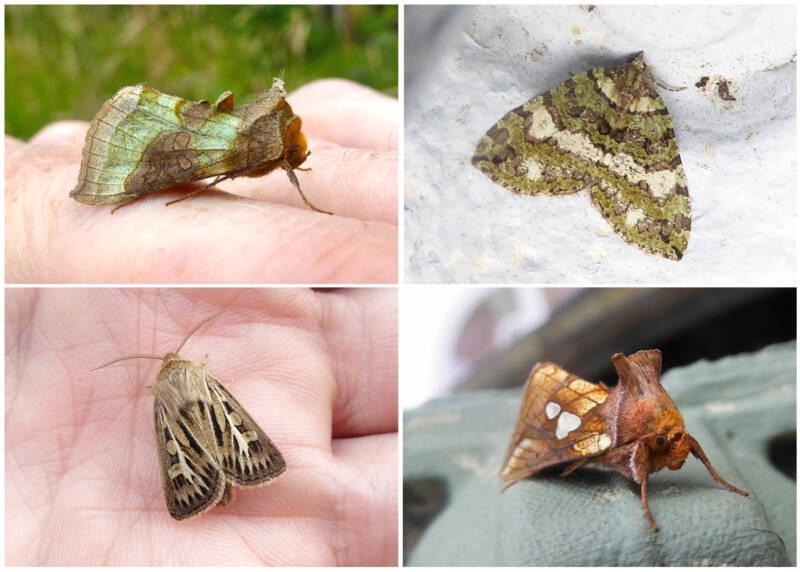
In total I reckon I had more than 50 species in the trap across those three nights, almost all of which I’d never seen before, and about two thirds of which I’ve actually managed to identify. My favourite of the lot was undoubtedly the Burnished Brass – a small but chunky moth with the most incredible metallic-green sheen. Sat on a twig, it would easily resemble an early autumn leaf. But there was genuine interest to be found in every single specimen.
The Gold Spot, bold and angular, looking more like an art deco window pane with its fine black lines drawn over a shimmering golden background.
The Beautiful Golden Y, with its reddish-brown wings, each one embellished with a knife-sharp white dot and hook, looking more like an abstract work of art than an insect.
The July Highflyer, its mix of green and brown stripes making it look like it had been kitted out in army fatigues.
The Lesser Swallow Prominent, an oddly artificial-looking thing that reminded me of a plastic toy spaceship I played with when I was a kid.
Or the Snout with its distinctive…erm….snout.
There’s so much diversity on offer within one group of insects. And if by this point moths still haven’t won you over, I hope you’ve at least warmed to them if only for their wonderful names. They make for an eccentric and evocative roll call, made all the more lovely by having the Heart and Dart, Pimpinel Pug, Brown-Line Bright-Eye, Argent and Sable, Lutestrings, True Lover’s Knot, or my personal favourite….the delightfully named Confused.
Childhood trauma aside, I’m not sure what puts people off moths so much. Their movements? Their furriness? The fact they’re creatures of the night? I dunno, but folk are definitely missing out. Moths might not be as immediately showy as their butterfly relations, but don’t let that fool you. They are some of the most bizarre and beautiful creatures you’ll ever encounter, and that’s before you even get to the caterpillars!
Personally, it’s been a long journey from indifference to delight, but I’m happy to say that the supposed drabness, their nondescriptness, which was formerly an obstacle to engaging with moths up close, has instead become an intrinsic part of their appeal. I love that feeling of excitement as something flutters past and you’ve no idea what it might be. Will it be a species you’ve not yet encountered? What stunning markings will it have? There’s only one way to find out, and I’d therefore encourage anyone and everyone to indulge in a little curiosity, and patiently wait for a moth to settle. Because I promise you, where moths are concerned, the more you look the more you see.
